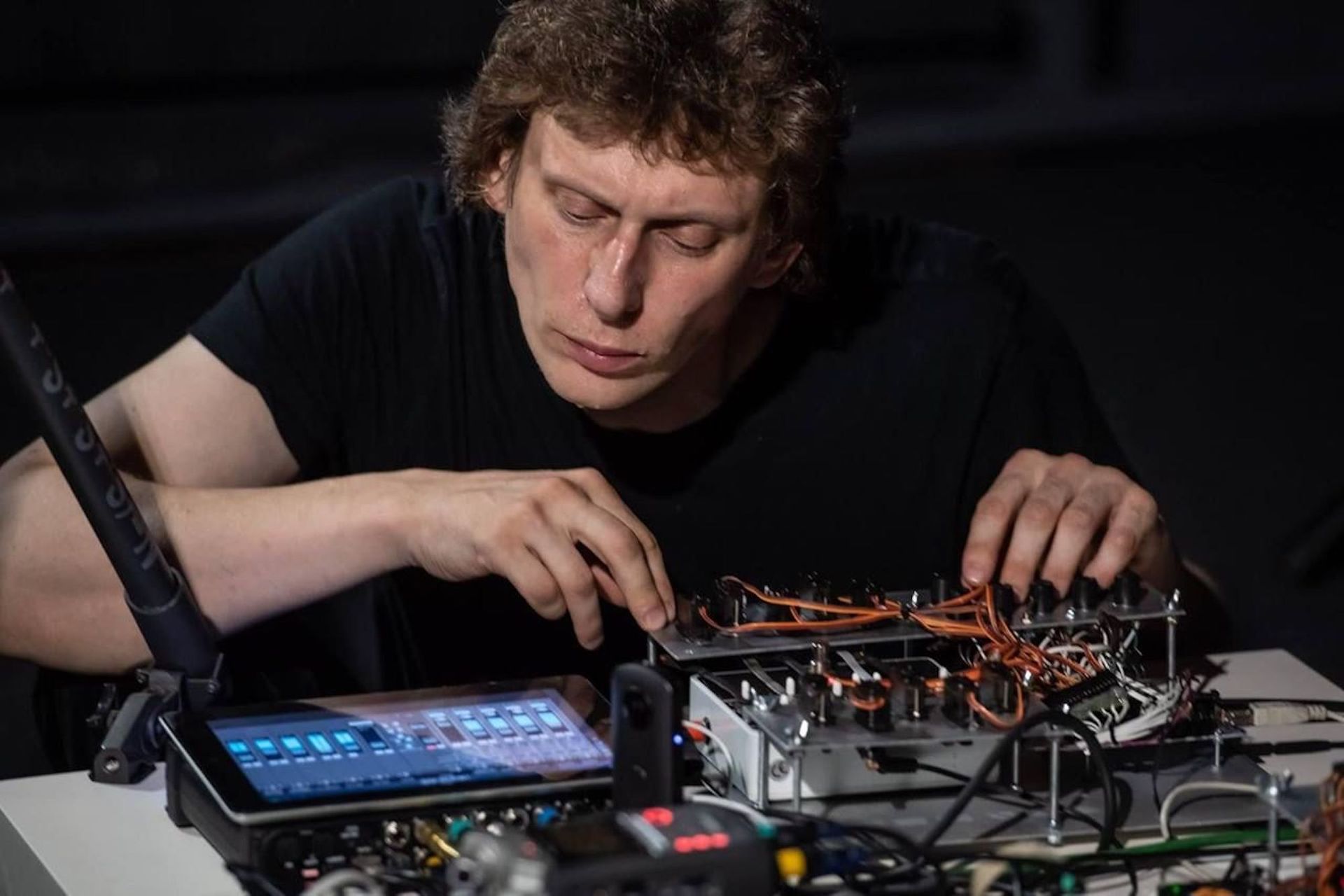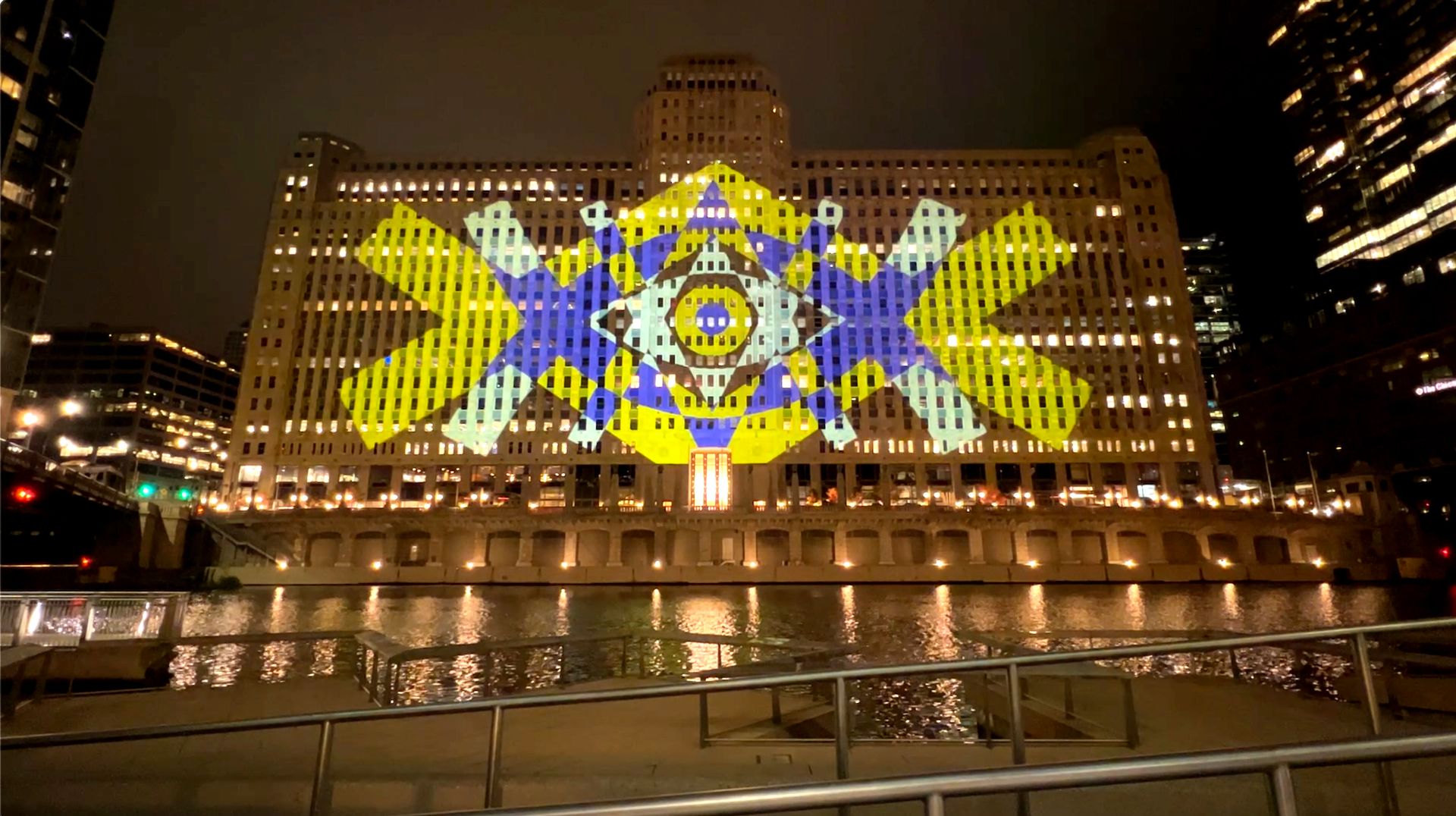The story of Shchedryk, a folkloric, hypnotically melodic early-20th century arrangement by Ukrainian composer Mykola Leontovych that became known internationally as Carol of the Bells, is being shown as a projection at Chicago’s Art on theMART (AOTM) public art site twice nightly for the next week (10-17 November).
The production was created by PHOTINUS, a studio of Kyiv light and sound installation artists and musicians who have been working in extreme wartime conditions and fighting on the front. Before Russia’s 24 February invasion of Ukraine, studio co-founders had participated in the Venice Biennale, Transmediale’s Vorspiel festival in Berlin, Ars Electronica in Linz, Austria and Ukraine’s Linoleum Contemporary Animation and Media Art Festival, which took place this year despite the war.
Shchedryk - Carol of The Bells: Unwrap the Holiday Magic was already in the works before the Russian invasion. It was initially planned as a celebration of Ukrainian identity and cultural diplomacy, projected during last year’s Christmas holiday season onto the facade of the Diplomatic Academy in Kyiv, with the idea to present adaptations elsewhere, primarily in the US and Canada. At first the war put the project on hold, but then made it even more important.
“We really recognised the artistic and technological capabilities of the PHOTINUS Studio,” says Cynthia Noble, AOTM’s executive director. “We had seen images of what they had done in Kyiv and previous work, and just really appreciated how they can help us maximise the potential of this platform from a video mapping sense and of course artistic sense. And it also made sense for Chicago in terms of content because Chicago has such a large Ukrainian and Ukrainian-American community. We do typically a winter holiday program anyway, and it just made perfect sense for our platform. And then of course the world changed greatly in this year with the war and so the idea of amplifying Ukrainian cultural expression took on a whole other dimension.”

Shchedryk: Carol of The Bells by PHOTINUS Studios Courtesy of Art on theMART
AOTM, launched in 2018, is the world’s largest permanent digital art projection, at theMART building, a two-city-block, 25-storey centre on Chicago’s riverfront. Chicago has one of the largest Ukrainian diaspora communities in the US, with over 200,000 in Illinois now joined by 25,000 refugees from the war, Yevgeniy Drobot, Ukraine’s vice-consul in the city tells The Art Newspaper. Chicago’s Ukrainian Village features the Ukrainian National Museum and Ukrainian Institute of Modern Art.
“We understood that at a time when the Russian occupying forces destroy museums and art galleries, universities and historical monuments, take away the works of Ukrainian artists from the temporarily occupied territories or simply destroy them, the war on the ‘cultural front’ is especially important,” Drobot says. “With this project, we can help Ukrainian culture to ‘come out of the shadow’; of the invasive imperialism planted by Russian propaganda and support Ukraine on the ‘cultural front’’, draw the attention of the international community to Ukraine and its contribution to the world cultural heritage.”
The song, adapted by Leontovych from folk motifs as The Little Swallow that brings luck as harbinger of a bountiful harvest, was a cornerstone of cultural diplomacy under Symon Petliura, who led an independent Ukrainian state from 1918-1921, before it was subjugated by Bolshevik Russia. Shchedryk had its American debut at Carnegie Hall in 1922, which ultimately led to Carol of the Bells, the English-language adaptation by Peter Wilhousky, an American composer of Ukrainian-Rusyn origin.
Leontovych was killed in 1921, at age 43, by an agent of the Cheka, a secret police forerunner of the KGB.

Max Robotov of PHOTINUS Studio working on the light projection Shchedryk – Carol of The Bells: Unwrap the Holiday Magic Courtesy PHOTINUS Studio, Kyiv
Max Robotov, the PHOTINUS Studio lead artist on the project, has been serving on the front with the Armed Forces of Ukraine since the beginning of the war. In comments emailed to The Art Newspaper, he describes Shchedryk, created by Leontovych from “ancient sample of Ukrainian folklore”, as “one of the transversal images of our culture”, with pre-Christian roots that transformed over the centuries after Ukraine’s conversion in 988 into a Christmas song and ultimately into “a universal cultural treasure.”
“We wanted, by means of Shchedryk, to tell both the history of Ukraine and the modern world of global culture,” Robotov says. “We cannot say that this year's full-scale war had a big influence on our vision. But we wanted to emphasise important aspects—Ukraine is an independent country with a very long and rich history, but also Ukraine is an important part of world culture.”

Shchedryk: Carol of The Bells by PHOTINUS Studios Courtesy of Art on theMART
Leontovych’s fate is also “typical for most (however terrible it may sound) representatives of Ukrainian culture of the 20th century” and “shows as clearly as possible that the destruction of Ukrainian creators, whose Shchedryks were not written, were not heard—is a loss not only of the Ukrainian, but also world culture”, Robotov says.
The December 2021 version of Shchedryk was funded by the British and US embassies in Kyiv and the Western NIS Enterprise Fund (WNISEF).
The use of blue and yellow in the projection is, of course, “a reference to the Ukrainian flag, but these are expressive colours, and important for many cultures”, Robotov adds, and “the very combination of horizontal blue and yellow stripes is a rather universal and easy-to-read symbol of the sky and the flowering field, that is, a symbol of peace and prosperity”.



